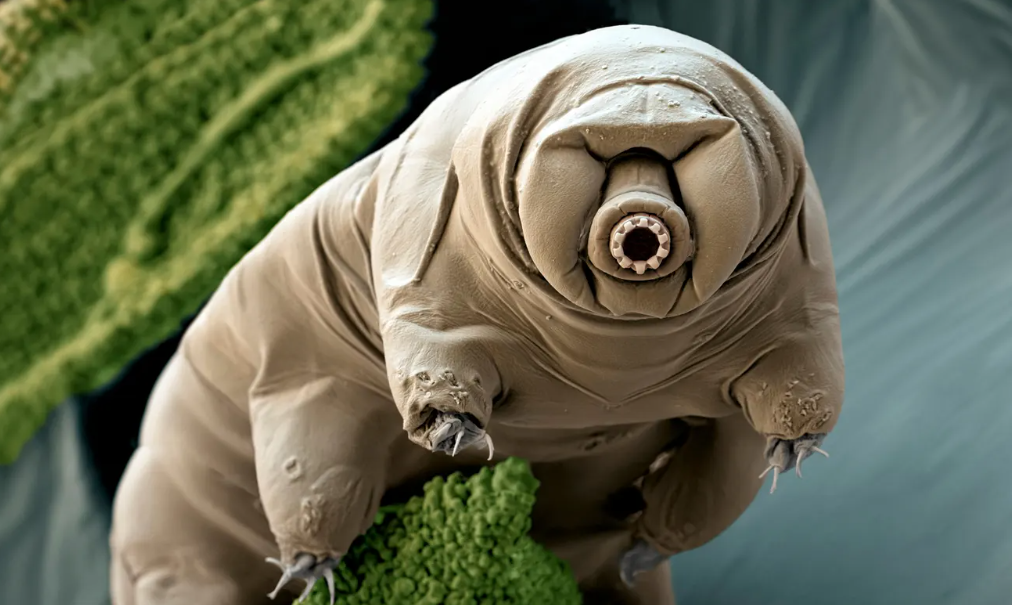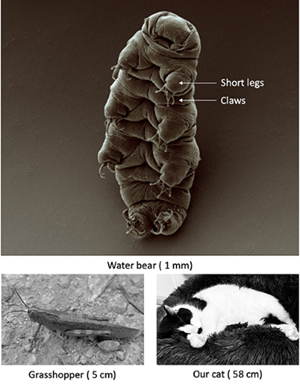By Rida Fatima

(Credit: Eye of Science/Science Photo Library)
Why do water bears exist? Are those bears actually there? It’s simple to respond “no,” as the only similarity between water bears and bears are that they are both animals. Water bears have a morphology that is somewhat similar to that of true bears, like the polar bear or the grizzly, but they are most closely linked to the enormous group of organisms known as the arthropods. This group of creatures, which consists of insects, spiders, millipedes, and crabs, is distinguished by its exoskeleton. However, due to their small size, water bears are invisible to the unaided eye. Their typical size is 1 mm. Over 200 years have passed since the discovery of water bears. They were first referred to as “little water bears” by German pastor and biologist Johann Goeze because of their diminutive size and fondness for wet conditions (Elleuche, 2021)

(Figure 1: Tardigrades are extremely small compared to other animals. The water bear micrograph by Bob Goldstein and Vicky Madden/grasshopper and the cat photograph by S. Elleuche)
Why water bears are considered as best animals to be sent on mars?
It is known that some microorganisms, including as bacteria, algae, fungi, and archaea, can endure the extreme environments found on other planets and/or moons (e.g. on Mars). Would it also be feasible with regard to higher organisms, such as animals? Specifically, tiny invertebrates called tardigrades? Mars is a relatively unfavorable environment for invertebrates from Earth because of its nearly nonexistent atmosphere, extremely low atmospheric pressure and temperatures, absence of liquid water, and significant doses of cosmic, ionizing, and UV radiation. On the other hand, it is still likely the Solar System location that is friendliest to terrestrial life (apart from the Earth). Numerous studies have demonstrated that nematodes, rotifers, and of course tardigrades are among a few types of cryptobiotic invertebrates that are the best prospects to thrive in Martian circumstances. More than 1,200 species of water bears make up the Phylum Tardigrada (water bears), which can be found in practically every terrestrial, freshwater, and marine ecosystem on Earth, from the deepest oceans to the highest mountains. Studies on survival in harsh environments frequently employ tardigrades as a model multicellular organism because they are among the strongest metazoans on Earth.

(Figure 2: Tardigrades in extreme environments. Łukasz Kaczmarek photo taken during the research.)
The capacity of tardigrades to enter cryptobiosis is responsible for their extraordinary resistance to harmful environments. The metabolic processes dramatically slow down or even stop in this state. Numerous studies shown that water bears are remarkably resilient to a wide range of environmental stresses, including a lack of liquid water, extremely high and low pressures, radiation, and numerous chemicals. Can we now question if this is sufficient for Mars survival? Additionally, studies have been carried out within the context of BARg operations (Biodiversity and Astrobiology Research group) (Kaczmarek, 2017).
Water Bear Genes Could Help Protect Space Explorers From Radiation
The genes that enable the resilient water bear to survive such extremes have been identified in a new analysis of the tardigrade genome, which may have ramifications for upcoming human space flight. One of the more resilient tardigrade species, Ramazzottius varieornatus, had its DNA examined by scientists from the University of Tokyo. They discovered numerous distinctive features of the genome through this study, including more copies of an antioxidant enzyme and a protein repair gene than were discovered in any other mammal. However, the gene of particular relevance codes for a protein that is specific to the species and probably shields it from radiation. The protein helps to repair radiation damage in addition to shielding the DNA in tardigrade cells from harmful radiation (Daley, 2016).
X-ray-damaged DNA is protected and repaired by a protein generated by the microscopic but tough tardigrades.
At first, it didn’t seem to matter that the scientists transplanted Dsup to grown human cells. The discrepancy, however, was “kept in the incubator for a time with the expectation that the difference would eventually become extremely obvious and that a critical attribute of Dsup lay concealed somewhere in that microscopic difference.” When the cells were reexamined under the microscope a while later, much to our great astonishment, their form and number had altered dramatically, exceeding our expectations. Particularly, over time, the Dsup assisted in DNA repair. This could be a significant advancement in the protection of human astronauts who would be exposed to high levels of cosmic radiation on upcoming missions to Mars and other planets. However, at the moment, it required genetic alterations to do this, which is not going to happen anytime soon. “Once Dsup can be introduced into people, it probably can enhance radio-tolerance”. The protein, according to the researchers, only provides about half the necessary protection, and it’s probable that the tardigrade uses additional defense mechanisms to defend itself from radiation. (Daley, 2016).
The discovery also settles a dispute that arose a year ago after a group of researchers from the University of North Carolina, Chapel Hill, published research asserting tardigrades have amassed roughly around 6000 genes from archaea, bacteria, fungus, and plants which are accounting for nearly 1/6th of the total genome. Furthermore, the concept was that through a process called as horizontal transfer, this particular specie had “borrowed” the genes that gave it its abilities from many other different species. However, after a back-and-forth with some other team that differed with the findings, the researchers rapidly came to the conclusion that the bulk of those genes were a result of contamination during the investigation. This new study took extra efforts to avoid contamination and examined genes obtained through horizontal transfer as well. According to their research, 1.2% of tardigrade genetic material originates from other species, which is not unusual in the animal realm (Daley, 2016). This fact highlights how remarkable the water bears are. Most of these extraordinary talents were independently developed by tardigrades.
References
- Kaczmarek. (2017, March). Can tardigrades theoretically survive on Mars? ResearchGate. Retrieved November 2022, from https://www.researchgate.net/publication/319213582_Can_tardigrades_theoretically_survive_on_Mars
- Elleuche. (2021, July). Water Bears—The Most Extreme Animals on The Planet (And in Space!). Frontiers for Young Minds. Retrieved November 2022, from https://kids.frontiersin.org/articles/10.3389/frym.2021.573691
- Daley. (2016, September). Water Bear Genes Could Help Protect Space Explorers From Radiation. Smithsonian Magazine. Retrieved November 2022, from https://www.smithsonianmag.com/smart-news/study-shows-how-water-bear-genes-could-protect-space-explorers-radiation-180960547/
